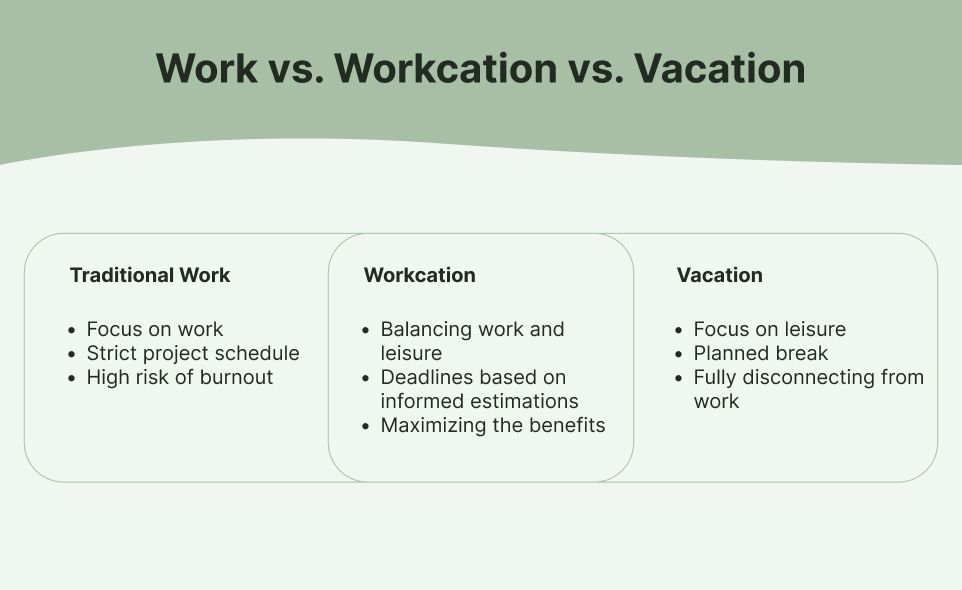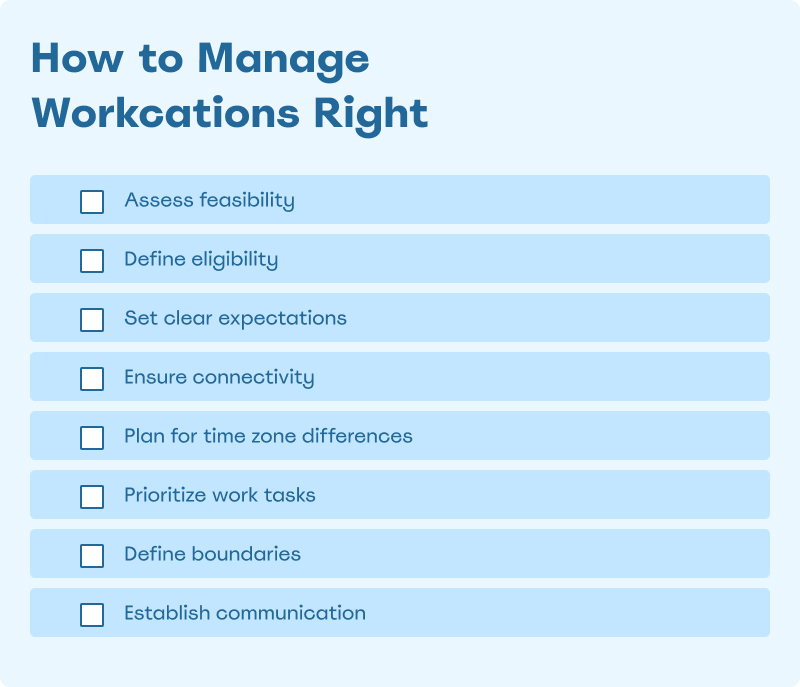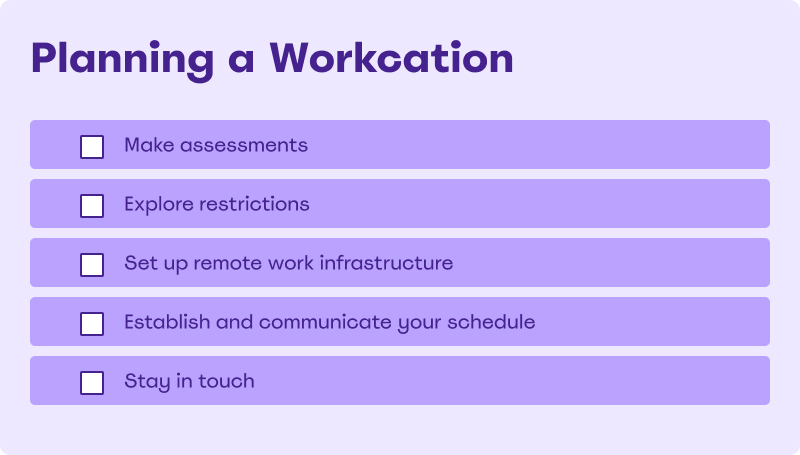Wi-Fi allows you to work remotely from anywhere on the planet and beyond. In the old days, it was only available for freelancers; today, things are changing.
Full-time employees combine holiday time with remote work and take a chance to swap their office desks for bounty retreats.
It is called workcation. Hip marketing specialists have been doing it for years, but for most of us (and surprisingly, the MS Word spellchecker), it is big news.
In this article, we’ll discuss everything there is to know about workcation and give some tips on how employees and businesses can use it to their advantage.
What Is Workcation?
The term blends the words “work” and “vacation.” It refers to a situation where individuals work remotely while also taking advantage of their location to enjoy leisure activities typically associated with vacations.
Work vs. Workcation vs. Vacation
During a workcation, individuals can work from any location with an internet connection, allowing them to choose destinations that offer a desirable environment or recreational opportunities. This could involve renting a vacation home, staying at a hotel, or traveling to a different city or country while maintaining work obligations.

Workcations can be an opportunity to combine business with pleasure by integrating work with travel. They can also be a way to improve productivity by getting away from the distractions of daily life or advancing your career while still enjoying traveling.
Laws Regulating Workcation
The regulatory landscape surrounding workations is still evolving, as it’s a relatively new concept. However, various laws and regulations can impact workations depending on the country and local jurisdiction. Here are some key areas of regulation that may apply:
- Remote work policies: Companies must ensure that their remote work policies comply with local employment laws, including wages, working hours, and employee rights.
- Labor laws: Employees on workations may still be subject to the labor laws of their home country, which can include regulations on working hours, overtime pay, and mandatory breaks.
- Income tax laws: Employees working in a different country may have tax obligations in both their home country and the country where they are working. Double taxation agreements (DTAs) may apply.
- Visa requirements: Some countries require specific visas for foreign workers. Employees should verify whether they need a work visa to legally work from another country.
- Health and safety regulations: Employers may have responsibilities regarding the health and safety of employees working remotely, even if they are in another country.
- Insurance requirements: Employers may need to provide adequate health insurance that covers employees while they are working from abroad.
- GDPR and privacy laws: For companies operating in the European Union or dealing with EU citizens, compliance with the General Data Protection Regulation (GDPR) is crucial, especially when employees access sensitive data from different locations.
A Guide to Workcation for Employers
Not every boss will gladly approve a workcation as it seems more beneficial for employees than employers. You just let relieve your workforce from most of their obligations and watch them do nothing and have fun for your money.
Actually, it’s not quite right. Workcation has both advantages and disadvantages for employers.
Here are the pros.
- Workcations provide a change of environment that stimulates creativity and motivation, leading to increased productivity and fresh perspectives on work-related tasks.
- Allowing employees to work from a vacation destination supports a healthier work-life balance.
- Offering workcation opportunities can be an attractive perk for new talents, especially those who value flexibility and adventure.
- You may save on expenses like office space, utilities, and travel reimbursements, mainly if your employees cover travel and accommodation costs.
And now to the cons…
- Depending on the destination, reliable internet access may not be readily available. This can cause frustration for employees trying to complete their work.
- Your staff may struggle to separate work and leisure time during a workcation.
- Physical disconnection from the “headquarters” may result in communication and collaboration challenges.
- Time zone differences, limited face-to-face interactions, and reduced spontaneous brainstorming sessions can hinder teamwork and project coordination.
- Workcations may create ambiguity around work expectations, mainly if employees are unclear on deliverables, deadlines, or availability.
Workcation Checklist for Employers
When considering workcations, you should carefully evaluate their organization’s specific needs and dynamics. If you are determined to try it, the checklist below will help you and your employees balance work and leisure while minimizing potential disruptions to business operations.

Assessing Feasibility
Evaluate the nature of your business and roles to determine if workcations suit your organization. Consider factors such as job requirements, team dynamics, and the availability of remote work infrastructure.
Defining Eligibility
Determine which employees are eligible for workcations based on their roles, performance, and responsibilities. Clearly communicate the criteria to ensure fairness and avoid misunderstandings.
Setting Expectations
Establish guidelines for workcations, including expectations for work hours, communication protocols, availability, and deliverables. Clearly communicate these expectations to employees to maintain productivity and avoid disruptions.
Ensuring Connectivity
Verify that the chosen workcation destinations have reliable internet access to ensure uninterrupted remote work. Research connectivity options or provide employees with the necessary tools for effective communication.
Planning for Time Zone Differences
Establish expectations for overlapping work hours and collaboration if workcations involve different time zones. Ensure employees know the potential challenges and communicate strategies for effective collaboration.
Prioritizing Work Tasks
Help employees prioritize their work tasks during the workcation period. Set clear deadlines, provide guidance on essential projects, and ensure that work is appropriately distributed among team members to avoid bottlenecks.
Defining Boundaries
Encourage employees to establish boundaries between work and leisure time during workcations. Emphasize the importance of downtime and self-care to prevent burnout and maintain a healthy work-life balance.
Establishing Communication
Determine the preferred communication channels for work-related discussions during workcations. Ensure employees can access appropriate tools for video conferences, instant messaging, and document sharing to facilitate collaboration.
A Guide to Workcation for Employees
Just imagine… Yoga by the pool in the morning. Peaceful worktime in the shade of palm trees with the ocean at your feet. You dive into the calm, refreshing waters every time you have a productivity crisis and then back to your pina colada-sided laptop… Working hours fly by like exotic birds in the nearby bamboo grove.
And then comes dinner time without having to cook after a long commute and exhausting shopping in the busy supermarket that drains you out completely after a long office day…
What is it tonight, yellowfin tuna or grilled lobster? Mmmm, that passion fruit salad looks delicious… No cleaning up or getting formally dressed. No driving and looking for a parking space. No rush or risk of being late. No household chores. No stress. Just work and relaxation.
Sounds awfully good, doesn’t it?
Yet no matter how dreamy this scenario may seem, workcation offers solid and proven employee benefits.
- You can change the setting for your working time. All of us have proved it – people return from vacations refreshed and full of energy, so why wait?
- Workcation gets your productivity rolling. Choose your dream location and jet off, laptop and swimsuit in your hand luggage.
- You save your precious vacation days! You relax, visit fantastic sights in the evenings or at weekends, do sports you can’t normally do in your free time – like surfing, and still get paid.
- You don’t have the usual stress of getting disconnected from work. You are aware of everything and attend all meetings remotely.
- You don’t need to readjust yourself to the office life that much – just to tight shoes, maybe.
Though workcations can be a great way to boost productivity and creativity, there are also some potential downsides that employees should be aware of.
- Workcations can be pretty expensive. If your company is not footing the bill for travel and accommodation, you could spend a lot of money out of your own pocket.
- Workcations can also be pretty disruptive to your regular routine and schedule. If you’re not careful, it can be easy to get caught up in the excitement of exploring a new place and forget about your actual work obligations.
- Even though workcations are supposed to be fun, they can be stressful. Trying to balance work with sightseeing and relaxation can be challenging.
- When you’re on a workcation, it may be harder for you to communicate with your team in real time, adhere to the agreed schedule and have everything under control.
Workcation Checklist for Employees
If your boss has okayed workcation despite all the above risks, you must ensure they made the right decision. Here are a few things you can do.

Making Assessments
Evaluate if your job allows remote work and if a workcation is feasible based on your responsibilities and deliverables. Initiate a conversation with your supervisor or manager to get approval and clarify any expectations or guidelines.
Exploring Restrictions
Select a destination that offers a suitable work environment and opportunities for leisure activities during non-working hours. Arrange suitable accommodation with a conducive work environment, such as a hotel with a dedicated workspace or a vacation rental with a reliable internet connection.
Consider factors like reliable internet access, time zone compatibility, and amenities that support remote work.
Research travel restrictions, visa requirements, or COVID-19 guidelines for your chosen destination. Ensure you comply with all necessary regulations and plan accordingly.
Setting up Remote Work Infrastructure
Pack your necessary work equipment, such as a laptop, charger, headphones, and any required tools or software. Back up important files and documents to ensure access from any location.
Establishing a Schedule
Create a schedule that balances work and leisure time. Set specific work hours and communicate them to your team or supervisor to manage expectations.
Inform colleagues or clients of your workcation plans and communicate your availability and preferred communication channels during this period. Set up out-of-office messages if required.
Staying in Touch
Regularly communicate with your team members or colleagues to stay updated on projects, share progress, and address any issues that may arise.
Provide feedback to your supervisor or manager for future consideration.
In the end, we must admit that workcation is not for everyone. Why mix apples and oranges if it’s easier to have a traditional vacation and really relax? However, for the adventurous lot and those who can think ahead and plan things well, go for it! Mix work and vacation, and maybe you will reach your Zen.



